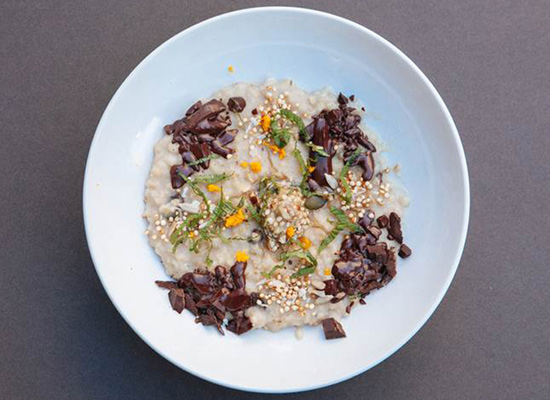為慶祝全球喝粥日,10日,倫敦舉辦了一場別開生面的煮粥大賽。各位參賽者挖空心思,煮出了花樣百出的粥品。
本屆煮粥大賽的冠軍斯坦博利煮出了一款色香味俱全的巧克力蜂蜜粥。傳統粥類冠軍贏得了一根金質攪粥棒。
塞繆爾·約翰遜博士過去曾認為,麥片粥在英格蘭就是馬食,只有蘇格蘭人才吃。如今,粥已經變成了一種很酷的食物。由于碳水化合物釋放較慢、富含能量和易消化等營養優勢,喝粥重新成為了時尚。越來越多的人開始喜歡上粥的那種簡單味道。

Dr. Samuel Johnson's dictionary once summarily dismissed porridge, defining oats as a "grain, which in England is generally given to horses, but in Scotland supports the people."
That was in the 1700s. These days, porridge is seen as more cool than gruel. Today is — and to celebrate, London hosted its own porridge-making competition.
"Most people think of porridge as a winter dish, and a richer, heavier dish. But I do think it's coming back in vogue. In the last 10 years, it's risen in profile," says Toral Shah, a competitor at Friday morning's event.
Porridge is traditionally Scottish, with its heritage in the oaty diets of crofters, or tenant farmers, of the remote Highlands. I'm a Scotsman, and porridge formed an integral part of my childhood. Winter would mean one thing for certain: a steaming hot bowl of the stuff every morning, before trudging through the snow to school.
Porridge is such a subjective thing. Mine was made with milk, occasionally dried fruit, and either brown sugar or golden syrup drizzled in the shape of a smiley face. Just as long as you remember to stir clockwise — stirring counter-clockwise risks summoning the devil, according to Scottish superstition.
Nick Barnard is a porridge traditionalist, and a judge in Friday's London Porridge Championships. "I have a bowl of oatmeal, flavored with salt and cooked just right — piping hot," Barnard says, explaining his technique. "I dip my spoon into the porridge, then into cold, raw Guernsey cream. ... And there I am, absolutely loving this wonderful simplicity."
Barnard runs London-based Rude Health foods, which sponsored Friday's competition. He was crowned last year's champion in the "speciality" category — he made a fruity date dish — at the World Porridge Making Championships, held annually in Carrbridge in the Highlands of Scotland.
The 21st world championship was held last weekend. Entrants competed in two categories: traditional and speciality. The winner in the former category takes home the "Golden Spurtle," a Scottish kitchen tool for stirring porridge, thought to have originated six centuries ago. Made of wood, it looks like a tiny baseball bat. This year's traditional winner, Dr. Izhar Khan, a kidney specialist from Aberdeen, Scotland, told NPR he credited his victory to the spurtle he used, made by one of his patients.
As for the prize for the speciality dish, it was awarded jointly to Chris Young and Christine Conte. Chris had turned savoury, putting together a wild mushroom porridge risotto, while Christina — a Scottish-Italian food blogger based in Los Angeles — made a sticky toffee porridge.
The winner of today's London event — personal fitness trainer Adam Stansbury — wowed the judges with his chocolate and honey porridge.
Fellow competitor Toral Shah is another health-food fanatic; she runs London's Urban Kitchen. The porridge competition, she says, "is a fun thing to do, it's slightly competitive, and I really want to show people that you can make things taste brilliant, but they can be really healthy, too."
Indeed, porridge's widely acclaimed nutritional benefits — slow-releasing carbohydrates, energy-rich and easy to digest — are credited in part for its resurgent popularity in recent years.
Some even credit porridge with changing the course of Scottish history. In his book The Scottish: A Genetic Journey, author Alistair Moffat argues that soon after the Scots began farming cereals thousands of years ago, they learned how to turn that harvest into porridge — a discovery that fueled the nation's population growth. His argument? Feeding children porridge — a meal soft enough not to tax fragile baby teeth — meant that women could stop breastfeeding sooner, freeing them up to have more children.
Modern Britons clearly haven't forgotten their roots. According to research firm Mintel, almost half of 16- to 24-year-olds in the U.K. surveyed last year said they start the day with porridge. And fast-casual food chain Pret A Manger's sales of hot cereals doubled in the U.K. in 2013.
But the porridge love has spread well beyond the U.K. Kahn's competitors in last week's championships included the owner of a porridge bar in Copenhagen, as well as Sweden's Nordic porridge-making champion.
So what does Barnard look for in a great serving of porridge? The first word he uses is "moreish" — how nourishingly delicious is it? He wants imagination, and something that's pleasing. The quality of the ingredients is also important for him. "Could I eat a whole bowl of it, and will it sustain me?"
For Toral, it's the experimental possibilities that make porridge so exciting. Take her beetroot and apple version, with hints of ginger, cinnamon, vanilla yogurt and spiced granola. "And it's apple season," she adds. "Why would you not go seasonal?"
So, tell us, how do you eat yours?
(來源:NPR 編輯:祝興媛)
